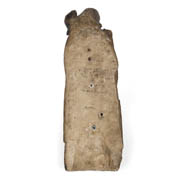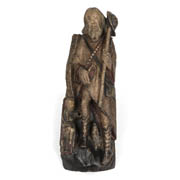Details
- Object type
figure
- Title
Saint Roch
- Place Associated
England (place of manufacture)
- Date
15th century
- Materials
alabaster, polychrome
- Dimensions
overall: 436 mm x 152 mm 5400 g
- Description
-
Alabaster figure of St Roch (San Rocco) (circa 1350-1380 - traditionally circa 1295-1327). The saint stands full-length, his head slightly inclined to his right, with long flowing hair and a beard. He is holding a pilgrim’s staff, mounted with a hat, in his left hand. He raises the hem of his tunic with his right hand to reveal plague marks on his thigh (no longer visible). A satchel hangs by his left side with the strap over his right shoulder, crossing a string of rosary beads strung over his left shoulder. At his feet a dog looks up to his infected thigh, and a small angel figure kneels beside his right leg. A scroll, which would originally have been painted with text, issues fourth from the angel and along Roch’s right side. The back of the panel is drilled with five holes, which would originally have been set with latten wire and plugged with lead, for fixing to a frame or setting. The bottom of the reverse has been cut away, providing a recess for ease of lifting.
There are remains of polychromy on the surface. The figures are set on a dark green ground, the underside of St Roch’s tunic is painted red and the satchel is painted black.
Despite his popularity throughout Western Europe and his widespread veneration, facts about the life and deeds of St Roch are few and often confused. According to some sources he was born in Montpellier in the south of France, where his father was governor. Following the death of his parents, Roch dedicated his life to pilgrimage, arriving in Italy during a plague epidemic. While in Italy he devoted himself to the care of the sick and was responsible for several miraculous cures. Upon catching the disease himself at Piacenza, he was either banished from the city, or withdrew of his own accord, to the forest to die. While awaiting death, a dog found him and provided him with food from his master’s table and eased his suffering by licking his wounds. Eventually the dog led his master, Count Gothard, to Roch, and he made a full recovery. Arriving back home in Montpellier he was rejected by his family and mistaken for a spy. He died after years of imprisonment, his true identity only recognised upon his death with the discovery of a cross-shaped birth mark on his chest.
Roch’s fame and cult spread rapidly after his death, with numerous miracles being cited at his tomb. In 1414, during the Council of Constance in Germany, the council ordered public processions and prayers in honour of Roch to combat an outbreak of plague which had struck the region, upon which, it is said, the plague ceased. His relics were moved to Venice in 1485, where they are still venerated.
Saint Roch is regarded as patron saint to (amongst others) bachelors, dogs, invalids, the falsely accused, pilgrims, apothecaries, second-hand dealers, and surgeons. However, the spread of his cult in the Middle Ages was in no small part due to his role as a healer of the sick and the patron saint of plague sufferers. In Germany he was associated with the Fourteen Holy Helpers (Vierzehnheiligen), a group of saints venerated for their effective intercession against disease.
Despite his popularity in the Late Middle Ages, only three other English alabaster pieces depicting St Roch are known, including a close parallel in the Victoria and Albert Museum, London (A.130-1946).
In Glasgow, St Roch is also known, uniquely, by the name St Rollox. The St Rollox area, to the north of the city, is believed to derive its name from Roch's Loch, a small loch that was once located by a sixteenth century chapel dedicated to the saint which stood on the site.
- Credit Line/Donor
Gifted by Sir William and Lady Burrell to the City of Glasgow, 1944
- Collection
Burrell Collection: Alabasters
- ID Number
1.41
- Location
Burrell Collection



